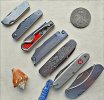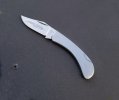Little Things Worth Knowing About Selling Pocket Knives 1931
"Most men are more particular about selecting their pocket knives than in choosing many other articles involving a much larger expenditure. They are anxious to get one that is "just right" and will frequently deliberate longer in making the choice of a $1.50 pocket knife than in selecting a $150 radio set. Nearly every man has a different conception of the kind of pocket knife best suited to his use. If the salesman takes pains to see that the customer is unhurried and is enabled to choose a knife that strikes his fancy to a "T," the store has gone far in acquiring a loyal, steadfast patron. The farmer usually favors a fairly heavy knife, of good quality, having three or four blades of varying shapes, in order that a suitable blade may be available for all ordinary uses. Usually, patterns having a punch blade, a castrating blade, and large and small blades for general purposes, are most popular with farmers. The size, shape, as well as the weight of the knife, the kind of handle, type of bolsters, and other factors, also receive due consideration. A fairly thick, "stocky" handle is…"
"...The office man and others following similar pursuits, generally prefer a smaller and lighter type of knife having two or more blades. In this instance, the prospect’s pocket knife requirements are governed by the need for a knife that will sharpen pencil, cut parcel twine, and serve as a manicuring aid. A small manicure blade is often favored while smooth handles, having rounded, bolstered ends and thin bodies, are popular"
[unfortunately, Google books isn't providing full access to the article. I actually pieced together that quote from 4 separate previews]




